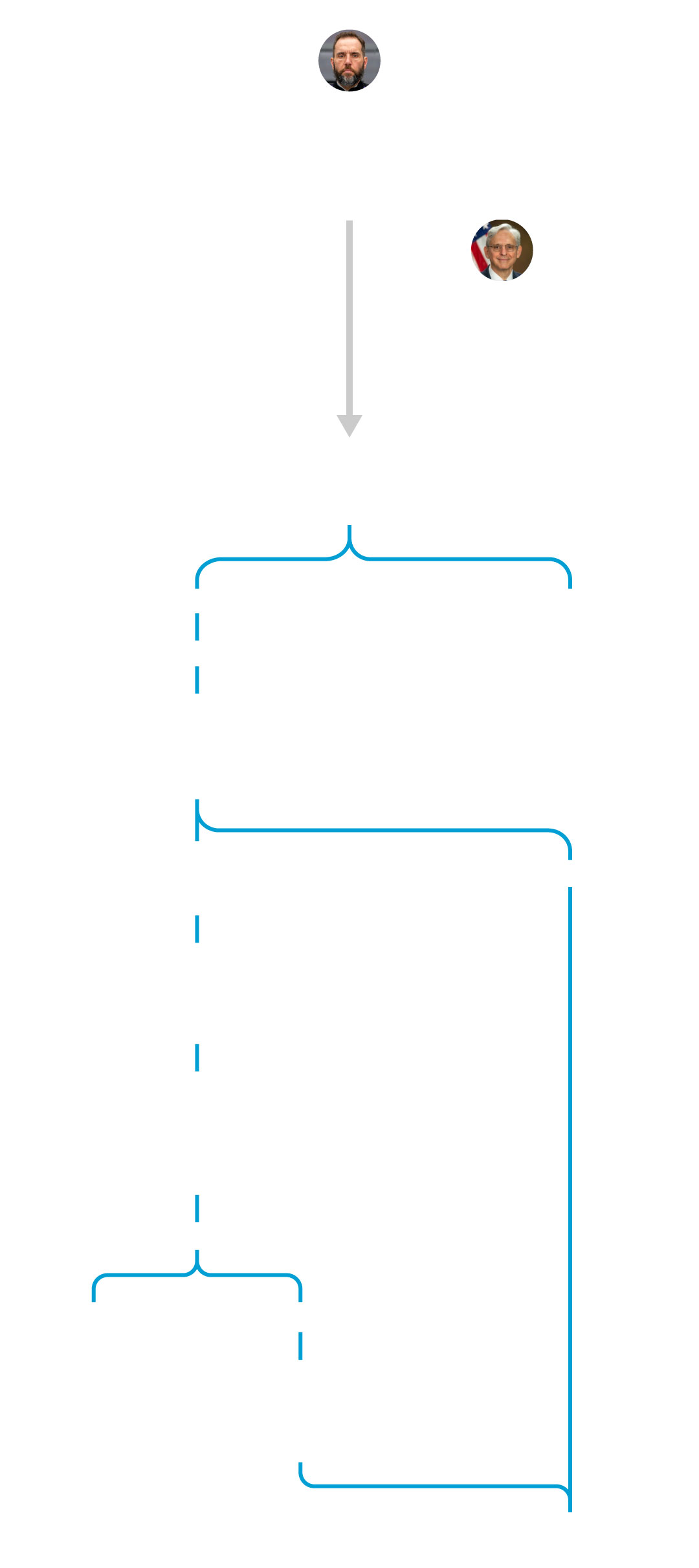
Prosecutor/Special Counsel Jack Smith
The prosecutor (special counsel in this case) and his
office present evidence to the grand jury during their
investigation. The special counsel prepares an
indictment and asks the grand jury for a vote.
Attorney general
The special counsel must
notify the attorney general
of significant events, such
as a decision to ask the
grand jury for indictment
Grand jury
Grand juries decide whether there is probable cause.
If so, a suspect is indicted.
Indictment
No indictment
Arrest
Initial hearing/Arraignment
The defendant appears before a
magistrate judge to hear charges
and enter a plea. The judge also
decides whether to grant bail.
Discovery
Guilty plea
Prosecution must share evidence
with defense during discovery.
Preliminary Hearing
Held within 14 or 21 days of the
initial hearing, the prosecutor
must prove there is enough
evidence to try the case.
Pre-trial motions
Attorneys on both sides may
motion the court to decide
certain issues, such as venue,
what evidence will be shown, or
whether to dismiss the case.
Trial
Not guilty
Guilty
Post-trial motions
Common post-trial motions
include asking for a new trial,
acquittal, or vacate, set aside, or
correct a sentence.
Sentencing

- Adjust height of artboards as needed
- At minium make 560px and 280px versions
- Delete the artboards that are not used
- Mono for labels and annotations
- Founders Condensed for headings
- Publico Text for text copy
- Font sizes:
10px, 12px, 14px, 16px, 18px, 20px, 24px, 32px, 48px, 60px, 80px, 96px, 128px
- Global Hex Colors:
black #000,
gray-100 #2a2a2a
gray-80 #555
gray-60 #999
gray-40 #ccc
gray-20 #ebebeb
white: #fff
red: #fa3a3a
- Brand Hex Colors:
midnight-blue: #102039; // News, MSNBC
clear-blue: #3061ff; // News, MSNBC
wilde-sand: #f2f2f2; // News
amber: #ffbe03; // MSNBC
plum: #380538; // TODAY
vermillion: #ff503c; // TODAY
alabaster: #f8f8f8; // TODAY
violet: #5c00d8; // MACH
biege: #f1f0ed; // MACH, BETTER, THINK, KNOW YOUR VALUE
burst: #ff5042; // THINK
tangerine: #f6a383; // KNOW YOUR VALUE
green: #13a31a; // KARA GREEN
orange: #f96419; // KARA ORANGE
pink: #db0e9c; // KARA PINK
dem-blue: #0495f4; // 2020 DECISIONS BLUE
rep-red: #ff3333; // 2020 DECISIONS RED
-Strokes
Grid stroke
Axis stroke
Line stroke
Annotation stroke
Prosecutor/Special Counsel Jack Smith
The prosecutor (special counsel in this case) and his office present evidence to the grand jury during their investigation. The special counsel prepares an indictment and asks the grand jury for a vote.
Attorney general
The special counsel must notify the attorney general of significant events, such as a decision to ask the grand jury for indictment
Grand jury
Grand juries decide whether there is probable cause. If so, a suspect is indicted.
Indictment
No indictment
Arrest
Initial hearing/Arraignment
The defendant appears before a magistrate judge to hear charges and enter a plea. The judge also decides whether to grant bail.
Discovery
Guilty plea
Prosecution must share evidence with defense during discovery.
Preliminary Hearing
Held within 14 or 21 days of the initial hearing, the prosecutor must prove there is enough evidence to try the case.
Pre-trial motions
Attorneys on both sides may motion the court to decide certain issues, such as venue, what evidence will be shown, or whether to dismiss the case.
Trial
Not guilty
Guilty
Post-trial motions
Common post-trial motions include asking for a new trial, acquittal, or vacate, set aside, or correct a sentence.
Sentencing

Prosecutor/Special Counsel Jack Smith
The prosecutor (special counsel in this case) and his office present evidence to the grand jury during their investigation. The special counsel prepares an indictment and asks the grand jury for a vote.
Attorney general
The special counsel must notify the attorney general of significant events, such as a decision to ask the grand jury for indictment
Grand jury
Grand juries decide whether there is probable cause. If so, a suspect is indicted.
Indictment
No indictment
Arrest
Initial hearing/Arraignment
The defendant appears before a magistrate judge to hear charges and enter a plea. The judge also decides whether to grant bail.
Discovery
Guilty plea
Prosecution must share evidence with defense during discovery.
Preliminary Hearing
Held within 14 or 21 days of the initial hearing, the prosecutor must prove there is enough evidence to try the case.
Pre-trial motions
Attorneys on both sides may motion the court to decide certain issues, such as venue, what evidence will be shown, or whether to dismiss the case.
Trial
Not guilty
Guilty
Post-trial motions
Common post-trial motions include asking for a new trial, acquittal, or vacate, set aside, or correct a sentence.
Sentencing

Prosecutor/Special Counsel Jack Smith
The prosecutor (special counsel in this case) and his office present evidence to the grand jury during their investigation. The special counsel prepares an indictment and asks the grand jury for a vote.
Attorney general
The special counsel must notify the attorney general of significant events, such as a decision to ask the grand jury for indictment
Grand jury
Grand juries decide whether there is probable cause. If so, a suspect is indicted.
Indictment
No indictment
Arrest
Initial hearing/Arraignment
The defendant appears before a magistrate judge to hear charges and enter a plea. The judge also decides whether to grant bail.
Discovery
Guilty plea
Prosecution must share evidence with defense during discovery.
Preliminary Hearing
Held within 14 or 21 days of the initial hearing, the prosecutor must prove there is enough evidence to try the case.
Pre-trial motions
Attorneys on both sides may motion the court to decide certain issues, such as venue, what evidence will be shown, or whether to dismiss the case.
Trial
Not guilty
Guilty
Post-trial motions
Common post-trial motions include asking for a new trial, acquittal, or vacate, set aside, or correct a sentence.
Sentencing